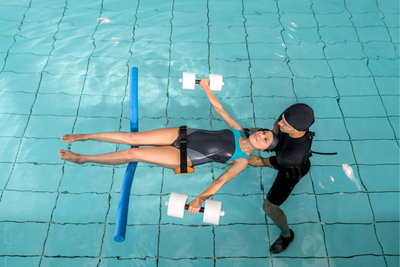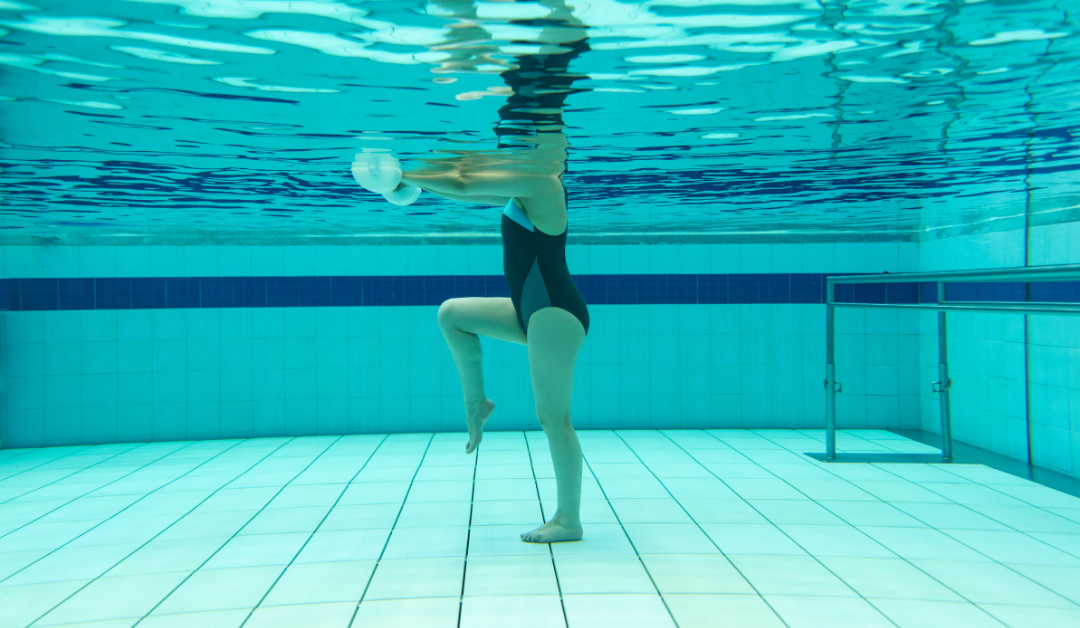Hydrotherapy minimises the stress on the muscles and joints, allowing normal and pain free movement and improving strength and flexibility.
What conditions can Hydrotherapy help?

Hydrotherapy is an effective and beneficial program that can help people suffering from many illnesses and conditions including back pain, Arthritis, Osteoporosis, headaches, joint, muscle and nerve problems, fibromyalgia, poor balance, sleep disorders and stress.
Hydrotherapy is a great treatment option for many people, especially pregnant women, or those suffering with Arthritis and Osteoporosis, because the water supports the weight of the body, reducing the impact on joints and provides greater resistance that allows the body to further strengthen muscles.
What are the Benefits of Hydrotherapy?
- Effective method for treating long-lasting pain
- Helps loosen tense, tight muscles, while encouraging relaxation
- Increases the metabolic rate and digestion activity
- Hydrates body cells while improving skin and muscle tone
- Boosts the immune system
- Stimulates blood supply to various organs in the body
What does a Hydrotherapy session involve?

Hydrotherapy is Physiotherapy in a heated pool. It is a program of exercises individually designed by a highly trained Physiotherapist or Exercise Physiologist, who work one on one with the client.
Initially you will need to visit your chosen specialist for a full assessment of your condition. A treatment plan will then be created specific to your needs and your sessions booked in advance.
Fear of water or poor swimming ability is no reason to avoid Hydrotherapy, as our Physiotherapist will supervise your activities in only waist deep water. The facility will provide any equipment required, or buoyancy vests if working deeper water, and you just need to bring along a towel, some water and optionally goggles and swim cap.
10 Simple Pool Exercises to become Pain Free
Before starting a pool based exercise program, always check with your Exercise Physiologist or Physiotherapist to make sure aquatic exercise is safe for you and follow your specific program where possible.
Here are 10 simple exercises that are often recommended –
- WATER WALKING AND JOGGING – Walking in water is a great exercise to start with as it helps you get a feeling for how you can create resistance. Start off by walking forward and back along the bottom of the pool increasing the speed to make it more difficult. You can move onto jogging to increase the intensity. A good workout is jogging for 30 seconds followed by walking for 30 seconds for 5 minutes.
- FORWARD LUNGES – Take an extra-large step forward, keeping your weight on your heel and bend the front knee. Try to go to 90 degrees, not letting the forward knee move past your toes. Now come back to the starting position, then continue alternating legs. Try 3 sets of 10 on each leg and when this becomes easier you can progress to walking lunges.
- SINGLE LEG BALANCE – When standing on 1 leg, lift your other knee up to hip height. Try to hold for at least 30 seconds before you switch legs. Try for 5 sets of 30 seconds on each leg. This is a great way to improve your balance whilst in the safety of the water.
- SIDESTEPPING – Face the side of the pool and take sideways steps with your body and toes facing the wall. Try taking 20 steps down the length of the pool facing the same way and then go back. To move up to the next level, increase the speed of movement and try side skipping! Repeat 3 times in each direction.
- DEEP WATER BICYCLE- This is a great exercise for knee pain as you can exercise your legs without compressive loading on the knee joint. In deeper water, either attach a floatation belt or loop a foam noodle under each arm and around your body, and then move your legs as though you’re riding a bicycle. Try 5 continuous minutes or 30 seconds fast and 30 seconds easy.
- PUSH UPS – Standing facing the side of the pool, place your hands shoulder width apart on the pool edge. Bend your elbows, and bring your chest down until it almost touches the side of the pool, try to hold for 3 seconds and then push up and straighten elbows. Aim for 3 sets of 10 reps. To increase intensity, try this in shallow water or otherwise make it easier by moving to the deeper end of the pool.
- ARM RAISES – Standing in neck deep water, place your hands by your sides. Lift your arms straight out to the sides forming the letter “T”, and push down and bring them back down to your sides. Repeat this for 3 sets of 10. Try altering the exercise and muscle group by raising your arms up in front of you.
- STANDING DONKEY KICKS – Stand looking down the pool. The pool wall should be on one side of your body for support. Swing 1 leg forward with your knee straight, like you are kicking a ball, then swing back and return to the starting position. Repeat this on each leg for 3 sets of 10.
- WATER PLANKS- Hold a foam noodle out in front of you. Lean your elbows on the noodle. Keep your feet on the pool floor, and lean forward in a plank position with the noodle slightly submerged under water so that your elbows are perpendicular to the bottom of the pool. Hold this for as long as possibly, aiming for between 15-60 seconds depending on your core strength. Continue this for 3 sets.
- STANDING KNEE LIFTS – Stand facing the pool wall with both feet on the pool floor. Lift one knee up like you are marching in place and whilst your knee is level with your other hip, straighten your knee. Continue to straighten and bend your knee 10 times then repeat this on your other leg. Complete 3 sets of 10 on each leg and make it more difficult by performing the exercise without standing next to the pool wall.
Hydrotherapy at Sandgate Physical Health Clinic
All of our Hydrotherapy classes are run by our highly trained Physiotherapists on a Wednesday and Friday at the Sandgate Pool.
For more information or to book, please call us on 3869 1099 or BOOK ONLINE.

